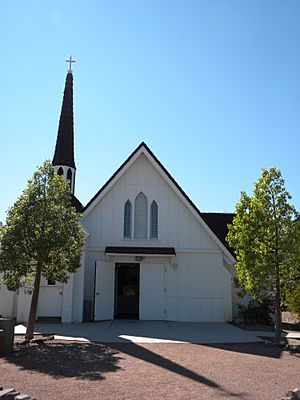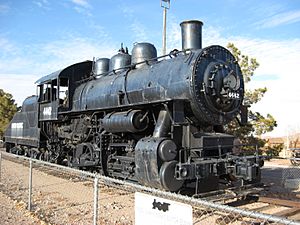Clark County Museum facts for kids
The Clark County Museum is a cool place in Henderson, Nevada. It's owned and run by Clark County. The museum has a main exhibit hall called the Anna Roberts Parks Exhibit Hall. It also has a special area called Heritage Street with eight old buildings from the county.
This museum teaches us about the history of southern Nevada. You can learn about the early Native American people, like the Paiute people. It also shows how important mining, the railroads, and even gaming (like casinos) were to the area. You can see old houses and even a pretend ghost town!
Contents
History of the Museum
How the Museum Began
The story of the museum starts with a woman named Anna Nuhfer Roberts. She came to Nevada in 1911. Anna and her husband traveled around southern Nevada for his work. During this time, Anna started collecting old things. She gathered historical items, cool minerals, and old clothes.
Anna continued to collect many items over the years. She stored her growing collection at her home. When it got too big, she moved some of it to an army building. But this place was not safe, and people broke in and stole valuable items.
A Museum for the Collection
In 1962, Anna Roberts Parks passed away. She left her collections to her daughter, Edith Jennings Mariano. Edith wanted to find a way to keep her mother's collection safe in southern Nevada. After another break-in at the storage building, a local historian named Maryellen Vallier Sadovich helped Edith.
Maryellen told Dick Pryor, a member of the Henderson Chamber of Commerce, about the collection. The Chamber was interested in creating a museum. However, they needed a place to put the collection and money to build a proper museum.
In January 1968, the collection was vandalized again. This made people act quickly. Glen Taylor, a school board member, helped secure the Townsite school's gymnasium on Water Street for the project. Within a short time, the collection was moved and secured in the school gymnasium.
Building the Museum Community
The new museum became a big community project for Henderson. Rules were made for the museum, and a contract was signed. This contract legally moved the collections from Edith to the Chamber of Commerce. The new museum officially became a legal group on March 19, 1968. It was first called the Southern Nevada Museum.
Later, the museum's name changed to the Clark County Museum or Clark County Heritage Museum. This is the name it uses today. The museum's administrator is Mark Hall-Patton. He is a historian who has appeared on the TV show Pawn Stars as an expert.
Museum Exhibits
Gaming Exhibits
- An 1898 Dewy slot machine is on display.
Historic Houses on Display
The museum has several historic houses that visitors can explore:
- An original Henderson B.M.I. townsite house from around 1941 to 1944.
- The Giles/Barcus House, built around 1905, came from Goldfield, Nevada.
- The Beckley House from 1912, originally from Las Vegas, Nevada.
- The Goumond House, built in 1935 and fixed up in the 1950s.
- The Babcock and Wilcox House from the 1930s.
- Another Townsite House from the 1940s.
The Candlelight Wedding Chapel, which used to be on the Las Vegas Strip, is now at the museum. It's located at the end of Heritage Street. An old railroad cottage from downtown Las Vegas has also been moved to the museum grounds. You can look inside from the porch to see old furniture.
Transportation Exhibits
- A 1932 Boulder City train depot.
- A 1946 Plymouth Coupe car.
- A 1959 Studebaker Lark car.
See also
 In Spanish: Museo del Condado de Clark para niños
In Spanish: Museo del Condado de Clark para niños



